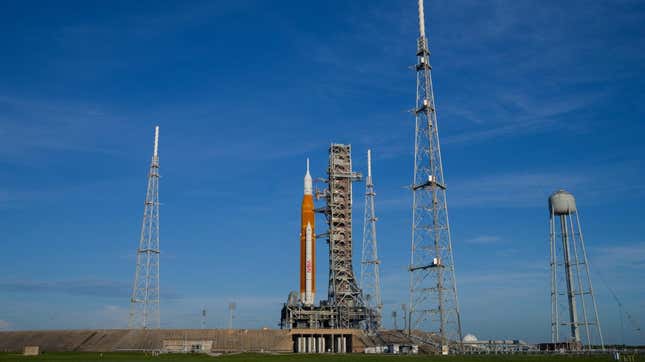
NASA’s first attempt to launch its Space Launch System megarocket did not go as planned, with officials declaring a scrub due an “engine bleed” issue. Sounds ominous, but NASA officials said Monday afternoon that a re-attempt on Friday is not out of the question.
At 8:34 a.m. ET, and with the countdown clock stuck at T-40 minutes, launch director Charlie Blackwell-Thompson declared an official end to the first SLS launch attempt. The unplanned hold began more than an hour earlier, as ground teams struggled to resolve an issue with one of the rocket’s four core stage RS-25 engines. Simply put, engineers couldn’t make the engine—specifically engine number three—cold enough for the launch, resulting in the scrub.
As ground teams prepared for launch, “we got to a problem that needed time to be solved,” Bill Nelson, NASA administrator, told reporters during an afternoon press briefing. “This is a brand new rocket that’s not going to fly until it’s ready.” Nelson took the opportunity to remind reporters that his trek aboard the Space Shuttle Columbia in 1986 was prefaced by four scrubs that transpired “for the better part of a month,” he said. SLS is incredibly complex, he added, saying this complexity becomes all the more “daunting when you bring it all into the focus of a countdown.”
The Artemis era will have to wait, but hopefully not for long. Mike Sarafin, Artemis mission manager at NASA, said “Friday is definitely in play,” in reference to the next available launch window that opens on September 2. The rocket continues to stand on Launch Pad 39B at Kennedy Space Center in Florida, where teams are holding SLS in its countdown configuration, he said. Early indications suggest it’s unlikely the engine would need to be replaced, Sarafin added.
The problem pertains to the “hydrogen kickstart” of the four RS-25 engines, in which liquid hydrogen chills the engines prior to launch. “We need to be at cryogenically cool temperatures” such that the engines are “not shocked by the cold fuel that flows through” during launch, Sarafin explained. Three of the four RS-25 engines were sufficiently chilled, but engine number three refused to abide; the flow of liquid hydrogen through this engine was less than expected, and measures to increase the flow failed to remedy the problem. In total, engineers spent two and half hours trying to resolve the issue with the engine’s hydrogen bleed line, to no avail.
Importantly, this system was not tested during the last wet dress rehearsal, which means this is the first opportunity for the teams to observe, and subsequently troubleshoot, this problem. As to whether the problem can be resolved in time for Friday’s launch window remains an open question.
Jim Free, associate administrator for Exploration Systems Development Mission Directorate at NASA, said “we’re not going to have all the data or implications today.” NASA says it will hold another press conference tomorrow, when more information could be disclosed, including a possible re-scheduling of the Artemis 1 launch. NASA says SLS and the Orion spacecraft remain in a safe and stable configuration.
In addition to the RS-25 chilling anomaly, ground teams also encountered an issue with a hydrogen spike, which was easily resolved. Aside from these problems and a leaky vent valve, today’s tanking went relatively smoothly. That said, Sarafin said a launch would’ve been a no-go today regardless, due to rain and lightning.
There are two more windows within the current flight period: one starting at 12:48 p.m. ET on Friday, September 2, and the other at 5:12 p.m. ET on Monday, September 5. Failing these, there are other launch windows available between September 20 and October 4.
For the Artemis 1 mission, SLS will send an uncrewed Orion capsule on a 42-day mission to the Moon and back. SLS, with its 8.1 million pounds of thrust, is the largest rocket NASA has ever built, and it will play a key role in the upcoming Artemis missions to the Moon, including the first human mission to the lunar surface since the Apollo era.
More: NASA’s Artemis Moon Landing Program: Launches, Timeline, and More.